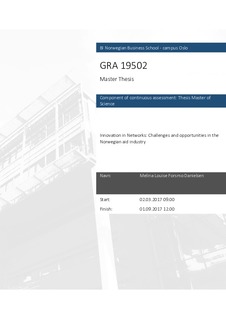Innovation in networks : challenges and opportunities in the Norwegian aid industry
Master thesis
Permanent lenke
http://hdl.handle.net/11250/2478776Utgivelsesdato
2017Metadata
Vis full innførselSamlinger
- Master of Science [1621]
Sammendrag
Pursuing innovative activities in collaboration with other actors in a network may
entail both challenges and opportunities for firms. While the traditional approach to
innovation was that firms should keep their work secret to ensure a head-start over
any potential competitors, the focus is turning towards the benefits of collaborative
innovation. The idea is that firms that combine their skills, knowledge, and
resources may achieve ends that none of the firms could have achieved in isolation.
Innovative partnerships may occur between customers, suppliers, or other actors
that a firm may obtain access to through its network. To be able to facilitate such
innovative partnerships, in-depth knowledge of the challenges and benefits firms
experience in such situations are pertinent.
The Norwegian aid industry has a pressing need to constantly improve the solutions
it offers to humanitarian issues. Additionally, the Norwegian aid industry has a
constructed network established by the governmental funded network provider
NOREPS, which aim is to foster humanitarian innovation. Three case firms have
participated in this multiple case study. Through various approaches, they have
developed new and innovative products that satisfies different needs in the aid
industry. Their different methods, needs, and varied success ensures interesting
contributions to the question of opportunities and challenges related to collaborative
product and market innovation.
This study identifies customer and supplier relationships as the most valuable and
most used partnerships among the participating firms. Collaboration across
business logics, here represented by profit-seeking firms and non-profit
humanitarian organisations, present the most challenges and opportunities. The
main challenges identified are social and cultural differences, lack of trust, lack of
communication, risk aversion, low degree of knowledge transfer, late customer
involvement, unawareness of common goals and tender based procurement
procedures. The main opportunities are those factors that enables firms to overcome
these challenges and make use of the existing actor variety in terms of skills,
knowledge and resources. Increased communication, a focus on common goals, risk
reduction measures, early customer involvement, and mutual understanding for the
other’s way of operating represents great opportunities for collaborative innovation.
Beskrivelse
Masteroppgave(MSc) in Master of Science in Business, Strategy - Handelshøyskolen BI, 2017
